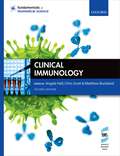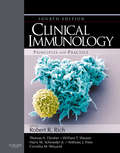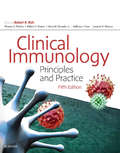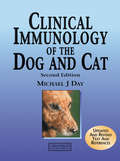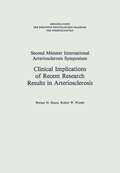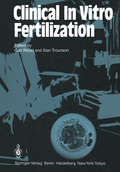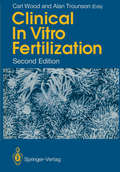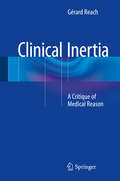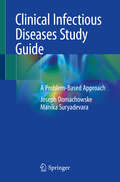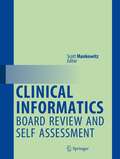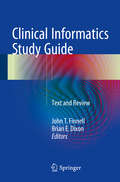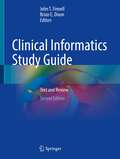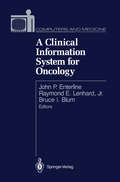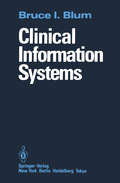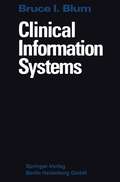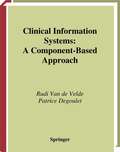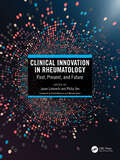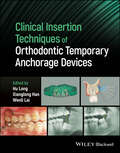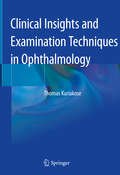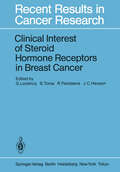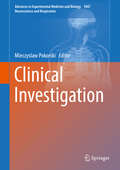- Table View
- List View
Clinical Immuno-Oncology - E-Book
by John E. NiederhuberOffering focused, practical, and up-to-date content on immunotherapies used to treat a wide variety of cancer types, Clinical Immuno-Oncology covers the basic cellular and molecular mechanisms involved in cancer initiation and progression. The text reviews the development of tumor specific antigens and the challenges of developing cancer immunotherapies. Every effort is made to relate the fundamental aspects of host immunity to the efficacy of current immunotherapies and how they work in conjunction with the immune system to combat cancer. This foundational resource explains the basics of cancer immunotherapy, discusses best practices, and provides recommendations from experienced clinicians in the field. Dr. John E. Niederhuber and a team of expert contributing authors provide clinically focused information essential for integrating these new therapies into practice—making this an ideal resource for fellows, practitioners, and other cancer team members in medical oncology, radiation oncology, cancer surgery, immunology, and cancer research. Offers balanced and synthesized content on clinical science, clinical and translational research, and evidence-based practice for cutting-edge immunotherapies. Discusses clinical applications of immunotherapies in common types of cancer including melanoma, breast cancer, pancreatic cancer, colon and rectum cancer, prostate cancer, leukemias, and hematologic malignancies. Includes dedicated chapters on immune responses, innate immunity, active immunization against cancer, and cell-based therapies by leading experts. Covers key topics such as cancer immunotherapy in the presence of COVID-19, immunotherapeutics, new findings concerning the role of the microbiome in immunotherapy, advances in engineered cell-based therapies, and active immunization against cancer.
Clinical Immunology (Fundamentals of Biomedical Science)
Biomedical scientists are the foundation of modern healthcare, from cancer screening to diagnosing HIV, from blood transfusion for surgery to food poisoning and infection control. Without biomedical scientists, the diagnosis of disease, the evaluation of the effectiveness of treatment, and research into the causes and cures of disease would not be possible. The Fundamentals of Biomedical Science series has been written to reflect the challenges of practicing biomedical science today. It draws together essential basic science with insights into laboratory practice to show how an understanding of the biology of disease is coupled to the analytical approaches that lead to diagnosis. Assuming only a minimum of prior knowledge, the series reviews the full range of disciplines to which a Biomedical Scientist may be exposed - from microbiology to cytopathology to transfusion science. Clinical Immunology gives the new biomedical scientist an insight into the function of the immune system, the front line of defence against pathological disease, and the diagnostic techniques used to identify associated malfunctions and disorders. By examining the key immunological principles and scientific basis of laboratory techniques with a focus on the biomedical scientist's role in the diagnostic laboratory, the reader is provided with everything needed to prepare for a specialist qualification in immunology. Current tests, the rationale behind their use, the technologies employed, and the quality measures applied are illustrated by specific case studies showing how the clinician interprets the results to help the patient. Online Resource Centre The Online Resource Centre to accompany Clinical Immunology features: For registered adopters of the book: - Figures from the book, available to download For students: - Answers to self-check and end of chapter questions - Video podcasts including interviews with practicing biomedical scientists and 'in the lab' footage showing biomedical science in practice
Clinical Immunology E-Book: Principles and Practice
by Robert R. Rich Thomas A. Fleisher William T. Shearer Harry W. Schroeder Jr. II Anthony J. Frew Cornelia M. WeyandOffer your patients the best possible care with clear, reliable guidance from one of the most respected and trusted resources in immunology. Authoritative answers from internationally renowned leaders in the field equip you with peerless advice and global best practices to enhance your diagnosis and management of a full range of immunologic problems.Depend on authoritative information from leading experts in the field who equip you with peerless advice and global best practices to enhance your diagnosis and management of a full range of immunologic problems.Focus on the information that’s most relevant to your daily practice through a highly clinical focus and an extremely practical organization that expedites access to the answers you need.Stay at the forefront of your field with cutting-edge coverage of the human genome project, immune-modifier drugs, and many other vital.
Clinical Immunology E-Book: Principles and Practice
by Robert R. Rich Thomas A. Fleisher William T. Shearer Harry W. Schroeder Jr. II Anthony J. Frew Cornelia M. WeyandKeep abreast of the latest advances in this complex field with the 5th Edition of Clinical Immunology: Principles and Practice. This substantially revised edition by Drs. Robert R. Rich, Thomas A. Fleisher, William T. Shearer, Harry W. Schroeder, Jr., Anthony J. Frew, and Cornelia M. Weyand, offers authoritative guidance from some of the most respected global leaders in immunology, helping you navigate today’s latest knowledge and evidence-based practices that result in improved patient care. This trusted resource features sweeping content updates, rewritten chapters, a highly clinical perspective, and an easy-to-use organization designed to enhance your diagnosis and management skills in daily practice.Includes new chapters on the Microbiota in Immunity and Inflammation, Immune Responses to Fungi, and Genetics and Genomics of Immune Response. Features extensive revisions to many chapters, including the Major Histocompatibility Complex, Multiple Sclerosis, Diabetes and Related Autoimmune Diseases, Biologic Modifiers of Inflammation and Tumor Immunotherapy. Covers hot topics such as the role of genetics and genomics in immune response and immunologic disease, atherosclerosis, recurrent fever syndromes, aging and deficiencies of innate immunity, the role of microbiota in normal immune system development and the pathogenesis of immunologic and inflammatory diseases, and novel therapeutics. Addresses notable advances in key areas such as the importance of the microbiota to normal immune system development and to the pathogenesis of immunologic and inflammatory diseases; relationships between the innate and adaptive immune systems; progress in rapid and cost-effective genomics; cell signaling pathways and the structure of cell-surface molecules; and many more. Summarizes promising research and development anticipated over the next 5-10 years with "On the Horizon" boxes and discussion of translational research.
Clinical Immunology of the Dog and Cat
by Michael DayThis second edition of a bestseller details the manifestations, diagnosis and treatment of immune-related disease in the dog and cat. It is illustrated throughout in full color, to show and explain to the reader as clearly as possible the complicated principles of disease and immunodiagnostic tests, supported by clinical cases, gross and histopatho
Clinical Immunology of the Dog and Cat
by Michael DayThis second edition of a bestseller details the manifestations, diagnosis and treatment of immune-related disease in the dog and cat. It is illustrated throughout in full color, to show and explain to the reader as clearly as possible the complicated principles of disease and immunodiagnostic tests, supported by clinical cases, gross and histopatho
Clinical Implications of Recent Research Results in Arteriosclerosis (Abhandlungen der Rheinisch-Westfälischen Akademie der Wissenschaften #70)
by Robert W: Hauss Robert W. WisslerClinical In Vitro Fertilization
by Carl Wood and Alan TrounsonMan is entering a new era as a result of advances in human reproduction. Techniques have been developed to assist in the creation of man-artificial insemination and, now, in vitro fertilization (IVF). Soon, other new methods, based upon current advances of the IVF procedure, will develop to improve the quality of human reproduction. The book describes the conceptual framework and details of technique concerned with in vitro fertilization and embryo transfer (ET). Edwards and Steptoe first described the technique of IVF and ET and the subsequent births of two normal babies. Since then, the success rate of the system has been improved by the use of fertility drugs to provide more oocytes and preincubation to mature the oocyte before fertilization. As a result of the continued research from Melbourne and Cambridge, more than 100 babies have been born. A free interchange of information between the Cambridge and Melbourne groups has led to a predictable success rate of 15%-20% per laparoscopy, and infertility centres all over the world are now copying the techniques. It is an appropriate time to inform doctors and scientists to help them understand the various procedures involved in IVF and ET. While many advances will occur in the future, the establishment of high success rates in several of the critical steps in the procedure-oocyte pick-up rate (90%), fertilization (>90%) and early embryo development (70%-90% )-signifies that some of the new techniques are stabilized sufficiently to warrant transmission of information by text, rather than scientific journal.
Clinical In Vitro Fertilization
by Alan Trounson Carl WoodIn vitro fertilization has resulted in an estimated 4000-5000 births in the world. The procedure has been accepted in Europe, America and Australia and several hundred IVF clinics are operating successfully. The newer procedures of GIFf, embryo freezing and donor oocyte IVF have become established and are dealt with in several chapters. GIFf has become the procedure of choice for patients with infertility of unknown origin. Oocyte freezing represents an important new technology which is being developed. The routine IVF procedure has improved slightly; variation in results can be reduced by quality control of laboratory and clinical techniques. Male factor infertility has been dealt with by IVF in mild and moderate cases, but newer techniques will be required to deal with severe problems in the male. Most countries have accepted that the straightforward IVF pro cedure is ethical. Limitations concerning the use of donor oocytes and embryo experimentation exist in some religions and countries; legal control of the new reproductive technologies ranges from the passage of statutes to no control at all. Many countries are still considering the need for legislative control. The text endeavours to indicate new areas of importance and to guide those organizing services as to how to introduce newer technolo gies.
Clinical Inertia: A Critique of Medical Reason
by Gérard ReachClinical practice guidelines were initially developed within the context of evidence-based medicine with the goal of putting medical research findings into practice. However, physicians do not always follow them, even when they seem to apply to the particular patient they have to treat. This phenomenon, known as clinical inertia, represents a significant obstacle to the efficiency of care and a major public health problem, the extent of which is demonstrated in this book.An analysis of its causes shows that it stems from a discrepancy between the objective, essentially statistical nature of evidence-based medicine on the one hand and the physician’s own complex, subjective view (referred to here as “medical reason”) on the other. This book proposes a critique of medical reason that may help to reconcile the principles of evidence-based medicine and individual practice.The author is a diabetologist and Professor of Endocrinology, Diabetology and Metabolic Diseases at Paris 13 University. He has authored several books, including one to be published by Springer (Philosophy and Medicine series) under the title: The Mental Mechanisms of Patient Adherence to Long Term Therapies, Mind and Care., Diabetology and Metabolic Diseases at the Paris 13-University. He has also published Pourquoi Se soigne-t-on, Enquête sur la rationalité morale de l’observance (2007), Clinique de l’Observance, L’Exemple des diabètes (2006), and Une théorie du soin, Souci et amour face à la maladie (2010). An English adaptation of the first book is published by Springer (Philosophy and Medicine) under the title: The Mental Mechanisms of Patient Adherence to Long Term Therapies, Mind and Care.
Clinical Infectious Diseases Study Guide: A Problem-Based Approach
by Joseph Domachowske Manika SuryadevaraThis book is meticulously designed for the busy student, trainee, or seasoned physician looking to enhance or refresh skills in infectious diseases. It is intended to provide a solid resource for students and physicians in need of a concise yet comprehensive background of the material. Each chapter begins with a summary of the topic, a brief case description, definitions, critical teaching points, and tables, figures, photos, and other visual materials to reinforce learning. The chapters take a systems based approach to infections before concluding with the essentials of diagnostic microbiology to leave users with a practical toolkit for real-world clinics.Authored by two expert educators and dual infectious diseases and pediatrics specialists, Clinical Infectious Diseases Study Guide is the only updated study guide designed for medical students, fellows, residents, and trainees who need a strong foundation in infectious diseases. This includes infectious disease specialists in both adult and pediatric care, various internal medicine subspecialists, and hospitalists.
Clinical Informatics Board Review and Self Assessment
by Scott MankowitzThe book offers an introduction to all the informatics concepts that are represented on the Clinical Informatics Board Examination The core and direction of this book is to mirror the model of clinical informatics which is used by the American Board of Preventive Medicine to create their exam. Unlike any other text on the market, the book includes simulated exam questions, to help the reader asses his knowledge and focus his study.Clinical Informatics Board Review and Self Assessment is a thorough practical assistant to refine the reader's knowledge regarding this youngest and possibly broadest fields of medicine.
Clinical Informatics Study Guide: Text and Review (Health Informatics Ser.)
by John T. Finnell Brian E. DixonThis books provides content that arms clinicians with the core knowledge and competencies necessary to be effective informatics leaders in health care organizations. The content is drawn from the areas recognized by the American Council on Graduate Medical Education (ACGME) as necessary to prepare physicians to become Board Certified in Clinical Informatics. Clinical informaticians transform health care by analyzing, designing, selecting, implementing, managing, and evaluating information and communication technologies (ICT) that enhance individual and population health outcomes, improve patient care processes, and strengthen the clinician-patient relationship. As the specialty grows, the content in this book covers areas useful to nurses, pharmacists, and information science graduate students in clinical/health informatics programs. These core competencies for clinical informatics are needed by all those who lead and manage ICT in health organizations, and there are likely to be future professional certifications that require the content in this text.
Clinical Informatics Study Guide: Text and Review
by John T. Finnell Brian E. DixonThis completely updated study guide textbook is written to support the formal training required to become certified in clinical informatics. The content has been extensively overhauled to introduce and define key concepts using examples drawn from real-world experiences in order to impress upon the reader the core content from the field of clinical informatics.The book groups chapters based on the major foci of the core content: health care delivery and policy; clinical decision-making; information science and systems; data management and analytics; leadership and managing teams; and professionalism. The chapters do not need to be read or taught in order, although the suggested order is consistent with how the editors have structured their curricula over the years. Clinical Informatics Study Guide: Text and Review serves as a reference for those seeking to study for a certifying examination independently or periodically reference while in practice. This includes physicians studying for board examination in clinical informatics as well as the American Medical Informatics Association (AMIA) health informatics certification. This new edition further refines its place as a roadmap for faculty who wish to go deeper in courses designed for physician fellows or graduate students in a variety of clinically oriented informatics disciplines, such as nursing, dentistry, pharmacy, radiology, health administration and public health.
A Clinical Information System for Oncology (Computers and Medicine)
by J.P. Enterline R.E. Lenhard, Jr. B.I. BlumA Clinical Information System for Oncology describes a medical information system designed and implemented in a cancer center but with broad applicability to medical practice beyond the cancer center environment in both inpatient and outpatient settings. Regarded as forward looking in 1978, the system has the distinction of still being in production. Indeed, its functionality has continued to grow and its technical implementation to evolve with the changing technology over the last decade. The authors detail the functions supported by this unique system, illustrate how it assists in the care process, review its development history, and evaluate its impact on the delivery of care in terms of cost, user satisfaction, and efficacy. Unlike much information technology, the system is an active participant in medical decision making: it includes comprehensive tools for managing and displaying clinical data; automatically produces care plans from protocols; and features unique tools which support the effective use of blood products. Professionals in medical informatics, hospital administrators, and physicians will find this book a valuable addition to their professional library.
Clinical Information Systems (Computers And Medicine Ser.)
by Bruce I. BlumAs its name implies, this book deals with clinical information systems. The clinical information system (or CIS) is an automated system with a long term database containing clinical information used for patient care. This definition excludes business systems (no clinical data), physiological monitoring systems (no long term database), and many research systems (not used in patient care). The theses of this book are (a) that CIS technology is mature, (b) that the CIS will have a major impact upon patient care and the health delivery system, and (c) that the number of commercial systems which now offer these potential benefits is very small. The objective of this book is to establish the above theses and thereby (a) inform both users and developers, (b) increase the demand for more sophisticated products, and finally, (c) provide marketplace incentives to advance the state of the art. The CIS is an application of computer technology for a specific class of problems. Its development requires a knowledge of the technology with an understanding of the application area. As with any tool-based application, the scope of the product will be limited by the capability of the tool. In the case of the CIS, reliable computers with comprehensive database facilities became com mercially available in the early 1970s. By the mid 1970s there was a maturation of the literature, and evaluations of 5-years' use began to appear. As will be shown, there have been surprisingly few new ideas introduced since the 1970s.
Clinical Information Systems: A Component-Based Approach (Health Informatics)
by Rudi Van de Velde Patrice DegouletHospital information systems (HIS) have become integral tools in the management of a hospital's medical and administrative information. With illustrated case studies, this book emphasizes clinical information systems (CIS) and their use in the direct management of the patient. Topics include the medical record, security, resource amangement, and imopaging integration.
Clinical Innovation in Rheumatology: Past, Present, and Future
by Jason Liebowitz Philip SeoTremendous advances have been made in the field of rheumatology, profoundly changing our understanding of many rheumatologic conditions and creating a new frontier for effective treatments. This book explains the most significant advances in research and care and speculates as to what will be the future of rheumatology over the next several decades, including challenges and lessons learned from past experiences in the field. It highlights landmark research articles and scientific discoveries, discusses how big data, personalized medicine, new biomarkers for disease, and other technological revolutions will shape the future, making it a must-have resource for physicians from all regions of the world. Key Features• Includes concise yet thorough description of the landmark studies and scientific breakthroughs coupled with easy-to-follow organizational structure of chapters that are accessible to readers at different levels of training.• Brings together world-leading experts to provide a fresh perspective to trainees such as residents and fellows-in-training, as well as more senior clinicians and researchers across the field of rheumatology and in specialties such as cardiology, dermatology, pulmonology, nephrology, and neurology, all of whom care for patients with rheumatologic conditions.• Allows the authors to imagine and speculate about the evolution of the field of rheumatology in the coming decades. Examples of such speculative possibilities include use of synovial biopsy to predict response to treatment in rheumatoid arthritis, replacement of renal biopsy with urinary proteomics in diagnosing and classifying lupus nephritis, use of new therapeutics to obviate the need for steroids in the treatment of ANCA-associated vasculitis, and the use of machine learning to evaluate subtle changes in imaging for management of inflammatory arthritis.
Clinical Innovation in Rheumatology: Past, Present, and Future
by Jason Liebowitz Philip SeoTremendous advances have been made in the field of rheumatology, profoundly changing our understanding of many rheumatologic conditions and creating a new frontier for effective treatments. This book explains the most significant advances in research and care and speculates as to what will be the future of rheumatology over the next several decades, including challenges and lessons learned from past experiences in the field. It highlights landmark research articles and scientific discoveries, discusses how big data, personalized medicine, new biomarkers for disease, and other technological revolutions will shape the future, making it a must-have resource for physicians from all regions of the world. Key Features• Includes concise yet thorough description of the landmark studies and scientific breakthroughs coupled with easy-to-follow organizational structure of chapters that are accessible to readers at different levels of training.• Brings together world-leading experts to provide a fresh perspective to trainees such as residents and fellows-in-training, as well as more senior clinicians and researchers across the field of rheumatology and in specialties such as cardiology, dermatology, pulmonology, nephrology, and neurology, all of whom care for patients with rheumatologic conditions.• Allows the authors to imagine and speculate about the evolution of the field of rheumatology in the coming decades. Examples of such speculative possibilities include use of synovial biopsy to predict response to treatment in rheumatoid arthritis, replacement of renal biopsy with urinary proteomics in diagnosing and classifying lupus nephritis, use of new therapeutics to obviate the need for steroids in the treatment of ANCA-associated vasculitis, and the use of machine learning to evaluate subtle changes in imaging for management of inflammatory arthritis.
Clinical Insertion Techniques of Orthodontic Temporary Anchorage Devices
by Hu LongClinical Insertion Techniques of Orthodontic Temporary Anchorage Devices Learn to design and insert Temporary Anchorage Devices with this groundbreaking guide. Clinical Insertion Techniques of Orthodontic Temporary Anchorage Devices is the first comprehensive guide to the clinical insertion techniques for temporary anchorage devices (TADs) and the clinical applications of TADs according to different anatomic regions. It provides detailed clinical insertion instructions and applications, as well as guidance on choosing an optimal insertion site, detailed insertion techniques, and potential complications and their solutions. Divided into five parts, the first covers general considerations, the second explores the techniques at different insertion sites, the third section delves into the clinical applications of miniplates, the fourth delivers the guided insertion of mini-implants, and the fifth section outlines the adverse effects of insertions. The result is a book which brings TADs into orthodontic practice in a rigorous and accessible way. Clinical Insertion Techniques of Orthodontic Temporary Anchorage Devices readers will also find: Around 800 photographs and illustrations demonstrating different insertion techniques and clinical applications Detailed coverage of all maxillary and mandibular regions as potential insertion sites Design and application guidelines for insertion guides Clinical Insertion Techniques of Orthodontic Temporary Anchorage Devices is indispensable for orthodontic clinicians looking for a reference on this area of orthodontics.
Clinical Insertion Techniques of Orthodontic Temporary Anchorage Devices
by Hu Long Xianglong Han Wenli LaiClinical Insertion Techniques of Orthodontic Temporary Anchorage Devices Learn to design and insert Temporary Anchorage Devices with this groundbreaking guide. Clinical Insertion Techniques of Orthodontic Temporary Anchorage Devices is the first comprehensive guide to the clinical insertion techniques for temporary anchorage devices (TADs) and the clinical applications of TADs according to different anatomic regions. It provides detailed clinical insertion instructions and applications, as well as guidance on choosing an optimal insertion site, detailed insertion techniques, and potential complications and their solutions. Divided into five parts, the first covers general considerations, the second explores the techniques at different insertion sites, the third section delves into the clinical applications of miniplates, the fourth delivers the guided insertion of mini-implants, and the fifth section outlines the adverse effects of insertions. The result is a book which brings TADs into orthodontic practice in a rigorous and accessible way. Clinical Insertion Techniques of Orthodontic Temporary Anchorage Devices readers will also find: Around 800 photographs and illustrations demonstrating different insertion techniques and clinical applications Detailed coverage of all maxillary and mandibular regions as potential insertion sites Design and application guidelines for insertion guides Clinical Insertion Techniques of Orthodontic Temporary Anchorage Devices is indispensable for orthodontic clinicians looking for a reference on this area of orthodontics.
Clinical Insights and Examination Techniques in Ophthalmology
by Thomas KuriakoseThis book elucidates the principles of sound clinical examination in ophthalmology. Based on the author’s extensive teaching experience, it makes the case for arriving at a diagnosis through detailed clinical examinations, including history taking, knowledge of clinical epidemiology, and using only the most relevant clinical tests. Starting with basic chapters on relevant statistics and clinical epidemiology, the book covers history-taking, visual function assessment, slit lamp examination, and examinations of each important field (e.g. the lids, orbit, cornea, iris and pupil, glaucoma patients, sclera, lens, posterior segment, pediatric patient and neuro-ophthalmology) in separate chapters. Full of practical tips on examining patients at the clinic, the book also describes the rationale behind each clinical test and its interpretation. It is also hoped that teachers who come across this book will evaluate students on the basis of these relevant clinical examinations rather than quizzing them on esoteric clinical tests that are not routinely used and are of little clinical value. This book is intended to help all ophthalmologists, beginners and veterans alike, improve their clinical examination thinking and skills.
Clinical Interest of Steroid Hormone Receptors in Breast Cancer (Recent Results in Cancer Research #91)
by G. Leclercq, S. Toma, R. Paridaens and J. C. HeusonSeveral papers dealing with the clinical relevance of steroid hormone receptors in breast cancer have already been published. However, no publication has overviewed studies currently being conducted in Europe, nor is there a register of the european centers performing receptor assays. It has been our purpose to fill these gaps. A large majority of authors who we contacted kindly agreed to con tribute to our book. Papers were grouped into six main parts according to their contents. The abundance of clinical data relevant to receptor assays led us to add critical summaries to help the reader to form his own opinions on the subject. We would like to thank Drs. R. J. B. King, G. Contesso, L. Santi, and E. Engelsman, who helped us in this regard. We hope that this book will enable the reader to become acquainted with the present state of European steroid hormone receptor studies devoted to breast cancer treatment. We also hope that it will promote cooperation between European oncologists involved in this field of research.
Clinical Investigation (Advances in Experimental Medicine and Biology #1047)
by Mieczyslaw PokorskiClinical investigation plays an essential role in the differential diagnosis, biomarker development, and therapy and cure of diseases. The book presents a bench-to-bed approach, with broad empirical coverage by experienced practitioners. The articles include topics like cytokine receptors in lung cancer, conduciveness of oxidative stress to carcinogenesis, safety and effectiveness of surgical correction of deformed chest, diagnostic and treatment regimens in inflammation-ridden obstructive lung conditions, alterations in growth hormone secretion leading to disorders of growth and metabolism, microbiota transplantation in pediatric patients, and the promising markers of renal epithelial injury. Yet another issue concerns the restructuring of chronic pain management by establishing the community-based specialized pain clinics. The book aims to disseminate and deliberate on the latest interdisciplinary medical knowledge to enhance clinical outcomes. Being a blend of clinical investigation and practice the book is addressed to physicians, scientists, and allied health care professionals.

